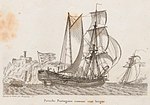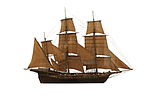Shipstory of Burgundie: Difference between revisions
Tags: Mobile edit Mobile web edit Advanced mobile edit |
mNo edit summary Tags: Mobile edit Mobile web edit Advanced mobile edit |
||
| Line 17: | Line 17: | ||
! Notable Engagements | ! Notable Engagements | ||
|- | |- | ||
| | |5700 BC and 5100 BC | ||
| | |Dugout canoes | ||
| | |Dugouts with ribs | ||
| | |[[File:Burg dugout canoes with ribs.jpg|100px|center]] | ||
| | |Unknown | ||
| | |N/A | ||
| | |N/A | ||
|} | |} | ||
Revision as of 06:57, 21 March 2024
Stone Age
Neolithic era
10,000 BC to 2200 BC
| Years | Style | Description | Picture | Number built | Navies of service | Notable Engagements |
|---|---|---|---|---|---|---|
| 5700 BC and 5100 BC | Dugout canoes | Dugouts with ribs | Unknown | N/A | N/A |
Bronze Age
Iron Age
Classical Antiquity
Medieval history
15th century
| Years | Style | Description | Picture | Number built | Navies of service | Notable Engagements |
|---|---|---|---|---|---|---|
| 1404-1546 | Carrack | A three- or four-masted ocean-going sailing ship that was developed in the 14th to 15th centuries in Levantia, most notably in Burgundie. Evolved from the single-masted cog, the carrack was first used for Occidental trade from the Istroyan Sea to the Ocean of Cathay and quickly found use with the newly found wealth of the trade between Levantia and Audonia and then the trans-Odoneru trade with Crona. In their most advanced forms, they were used by the Bergendii for trade between the Occident and Alshar starting in the late 15th century, before eventually being superseded in the 17th century by the galleon, introduced in the 16th century.
In its most developed form, the carrack was a carvel-built ocean-going ship: large enough to be stable in heavy seas, and capacious enough to carry a large cargo and the provisions needed for very long voyages. The later carracks were square-rigged on the foremast and mainmast and lateen-rigged on the mizzenmast. They had a high rounded stern with aftcastle, forecastle and bowsprit at the stem. As the predecessor of the galleon, the carrack was one of the most influential ship designs in history; while ships became more specialized in the following centuries, the basic design remained unchanged throughout this period. |

|
1000+ | Yes |
Early modern history
16th century
| Years | Style | Description | Picture | Number built | Navies of service | Notable Engagements |
|---|---|---|---|---|---|---|
| 1522-1625 | Galleon | A large, multi-decked sailing ships first used as armed cargo carriers by Occidental states from the 16th to 18th centuries during the age of sail and were the principal vessels drafted for use as warships until the Anglo-Dutch Wars of the mid-1600s. Galleons generally carried three or more masts with a lateen fore-and-aft rig on the rear masts, were carvel built with a prominent squared off raised stern, and used square-rigged sail plans on their fore-mast and main-masts.
Such ships were the mainstay of maritime commerce into the early 19th century, and were often drafted into use as auxiliary naval war vessels—indeed, were the mainstay of contending fleets through most of the 150 years of the Age of Exploration—before the Anglo-Dutch wars brought purpose-built ship-rigged warships, ships of the line, that thereafter dominated war at sea during the remainder of the age of sail. |

|
385 | Yes | |
| 1571-1656 | Race-built galleon | The description derived from their "raced" or razed fore-and aft-castles, which, combined with their greater length in relation to their beam, gave them a purposeful, sleek look. Their builders described them as having "the head of a cod and the tail of a mackerel". These ships were purposely designed and built to the new design, not razeed older galleons. | 
|
8 |
|
17th century
In 1604, the Royal Foreign Naval Training Association was formed by Rih Donan Suthar-Màrtainn, who was becoming frustrated only a year into his rule by Vithinjan piracy along Faneria's outer coast.The Association was rebranded as the Burgundine-Fhainnin Joint Naval Officers' College in 1738, absorbing the institution of the Royal Naval Academy and becoming the primary naval officers' academy for the Fhainnin navy.
- Conquest of northern Vallos and the decimation of the piratocracies (1599-1658).
| Years | Style | Description | Picture | Number built | Navies of service | Notable Engagements |
|---|---|---|---|---|---|---|
| 1601-1812 | Patache | A type of sailing vessel with two masts, very light and shallow, a sort of cross between a brig and a schooner, which originally was a warship, being intended for surveillance and inspection of the coasts and ports. It was used as a tender to the fleet of vessels of more importance or size, and also for trans-oceanic travel, but later began to be used for trading voyages, carrying cargo burdens of 30 tons or more. Over 1500 patache were built and used across the Burgoignesc colonial empire. It was the precursor to the aviso. | 
|
1500+ |
|
|
| 1615-1832 | Polacre-xebec | Burgoignesc design based on the Audonian xebec. 467 Polacre-xebecs were eventually built for the Ularien Trading Company, later renamed the Marialanii Ularien Trading Company in 1705, most of them were used in the conquest of Alshar, the Alshar Quasi-Wars, the Kandoori-Fana wars, the Great Rebellion of Slavery Bay, and to a lesser extent the First Fratricide. | 
|
~843 |
|
18th century
As with the latter quarter of the 17thcentury the line-of-battle remained the dominant tactic in naval engagements of the 18th century. Ever increasing ships of the line were built to increase the numbers of guns in the broadside. The typical practice was to measure a ship in the number of gun decks, but some principalities measured their ships by the total number of guns. Most ocean going princes and dukes used two-deckers, with some afford one or two three-decker flag ships.
1695-1846
Two-decker
A common design usually broken down into various configurations using the neolog "rates". Two-deckers ranged all the way from the small 40-gun Fifth rate up to 80- or even 90-gun ships of the line, with the third-rate of seventy-four guns, or "seventy-four", being the archetype.
1725-1824
Three-decker
An expensive and imposing design usually broken down into various configurations using the neolog "rates". Three-deckers were generally classed as first or second rates. The usage of three deckers ended in 1824 when the last one in service to Burgundie was sunk off the coast of Wintergen in a battle with Kiravian forces.
Late modern history
19th century
Kindred War
While not a direct participant in the war, Burgundie strongly supported Faneria in the Third Kin War and formed the backbone of its ship building capabilities. In 1821 Burgundie delivered a fleet of formidable ships to Faneria which was one of the major factors to its victory.
Kiro-Burgoignesc Wars
Prior to the unification of the southern coastal principalities of the Kingdom of Dericania under the banner of Burgundie in 1875 the navies varied greatly and money was spent mostly on mercantile ventures that could be pressed into service if needed. This lead to large, lightly armed ships being common in the various naval engagements of the early 19th century. Jeune École and the development of the clipper coalesced in the mid 19th century in Burgundie as the country fought in both the Southern Levantine Mediatization Wars and the Kiro-Burgoignesc Wars Kicked off when Burgundie invaded Wintergen in 1823 and annexed the island a nautical arms race lept into action. Kiravia focused on building ironclads while Burgundie built faster and sleeker warships with barbettes firing explosive shells. This style of warfare dominated the design of late century warships.
20th century
21st century
2021 3, October First confirmed "kill" using the laser weapons system by the Navy of Burgundie during Operation Khyzer Rhykh.
